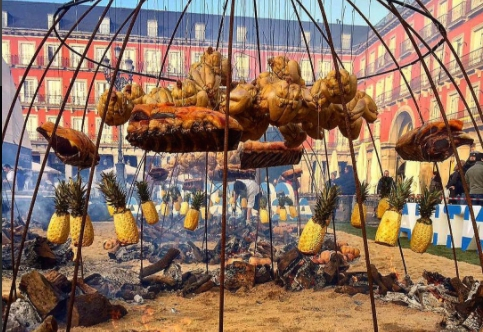The guest nation in the 15th edition of Madrid Fusion is Argentina. The crowd of white-and-blue chefs and producers invaded Palacio Municipal de Congresos with remarkable energy and ideas.
Of the many events scheduled, we were particularly struck by the lesson held by Mariana Müller, patron chef at Cassis in Bariloche, la capital de los lagos, in Patagonia, for the past twenty years. A very talented professional, whose capacity is certified by a several titles as “best female chef in Argentina”, given by magazines in her country, and by Paolo Marchi, who asked her to speak in Milan too, in little over a month, within the Identità Naturali section.
In the multi-functional room in Madrid, “la China”, this is how they call her back home given her vaguely oriental traits (though German blood runs in her veins), held a ponencia on sour cuisine, with fellow countryman Hernan Luchetti, an important pawn in the ironclad Celler de Can Roca in Gerona, Cataluña.

The maxi-asado that Francis Mallmann prepared in Plaza del Rey
In her restaurant
Mariana draws from a very rich source of vegetables, flowers, herbs, forest plants and fruits. Her place is wedged in between the mountain of Patagonia’s inland, a huge region, with the most varied ecosystems. Her work is in symbiosis with earth and roots, a transformation into preserves, sauces, resins that become juices, wines and then
vinagres, extraordinary vinegars. «To put it simply, my cuisine is a
cocina acida [sour cuisine]».
Lucchetti can’t believe he can use these «extraordinary products» (his words) for his demonstration which includes sheep vinegar and
kombucha, a sweet and fermented tea with a very high acid point (one of the most popular recipes in this edition in Madrid). Meanwhile, we learn from the two chefs how to change the semantic meaning of “acid”, which no longer has the negative meaning we often give in Italy but becomes a synonym of poetry, aroma, freedom, colour, magic, variety, memory.
The Argentinian three-day participation in
Madrid Fusión started with a spectacular
asado prepared by
Francis Mallmann, the most famous chef in the country, in the middle of Plaza del Rey. The
ponencia given by
Germàn Martintegui, a very popular chef running
Tegui in Buenos Aires, 68th in the
World’s 50 Best, received very sincere applauses. «You all imagine our country», he started, «as an orgy of meat
alla parrilla, today I don’t want to speak of this, but of our long cultural Pre-Columbian tradition».
The ponencia conveyed a very strong reference to earth, producers, and the roots of his country. With a clearly presented gastronomic principle: «If something is good, you need to touch it as little as possible». This was the imperative behind the concept of the two dishes he explained, which represented respectively the north and south of the huge country: lama raw meat with fermented dehydrated and fried
quihuicha (amaranth) and tunta potatoes (north) and grilled oysters
alla parrilla with apple wood, salicornia and sea foam.
On Tuesday, the lesson by
Thomas Kalika stood out. He works at restaurant
Mishiguene and is a rising star in the
judìa, Jewish, “immigrant” cuisine, the result of the all the influences these itinerating people absorbed around the world.
Read Paolo Marchi’s dossier from Argentina:
A guide to the best Argentinian restaurants
The dream of the chef from La Pampa
The poetry of Argentinian Asado
Argentina dreams of the Michelin guide
Argentina, a journey in history
Argentina is calling